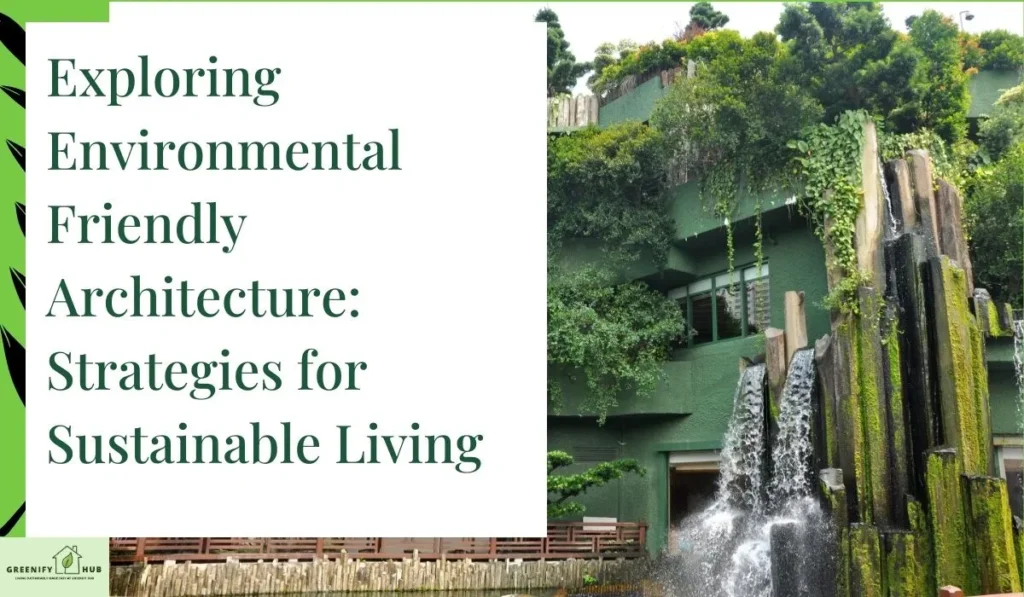Exploring Environmental Friendly Architecture: Strategies for Sustainable Living

Dreaming of a sustainable future where architecture harmonizes with nature? Imagine structures that not only stand out for their beauty but also leave a positive impact on the environment. Picture a world where every sustainable building structure contributes to a greener tomorrow. Can you envision a skyline filled with environmentally friendly architecture, blending seamlessly with the surrounding landscape?
Keep reading as we explore the innovative world of environmental friendly architecture, where design meets sustainability head-on. Discover how architects are revolutionizing the industry by creating spaces that prioritize energy efficiency, eco-friendly materials, and minimal environmental footprint.
Key Takeaways
- Embracing green architecture can significantly reduce the environmental impact of construction activities.
- Implementing strategies for green building, such as using renewable energy sources and sustainable materials, can lead to long-term cost savings and energy efficiency.
- Creating walkable urban spaces not only promotes physical activity but also reduces carbon emissions from transportation.
- Overcoming green building challenges, like high initial costs, through government incentives and subsidies can make eco-friendly design more accessible.
- The future of sustainable living lies in the hands of architects and builders who prioritize eco-friendly practices to combat climate change.
- The future of sustainable living lies in the hands of architects and builders who prioritize eco-friendly practices to combat climate change.
- Understanding the benefits of eco-friendly design and the negative impacts of traditional construction is crucial for promoting environmental consciousness in architecture.
Understanding Green Architecture
Core Principles
Green architecture focuses on minimizing the environmental impact of buildings by utilizing sustainable materials, optimizing energy efficiency, and reducing waste production. It also prioritizes natural light, ventilation, and green spaces to enhance occupants’ well-being.
Incorporating renewable energy sources like solar panels and wind turbines is a key aspect of sustainable architecture, reducing reliance on fossil fuels and decreasing carbon emissions. Another fundamental principle is water conservation through systems that recycle and reuse water within the building.
Formal Endorsement
Leading organizations such as the United Nations Environment Programme (UNEP) and the U.S. Green Building Council (USGBC) actively promote sustainable architecture. They establish guidelines and certifications like LEED (Leadership in Energy and Environmental Design) to encourage the adoption of eco-friendly building practices worldwide.
Pros:
- Reduced environmental impact
- Lower operating costs
- Healthier indoor environment
Cons:
- Higher initial investment
- Limited availability of sustainable materials
Modern Aesthetics and Eco-Friendly Elements
Sustainable architecture seamlessly blends contemporary design trends with environmentally conscious features. Architects integrate elements like green roofs, rainwater harvesting systems, and passive heating/cooling techniques to create visually appealing yet eco-friendly structures.
Impacts of Traditional Construction
Global Energy-Related CO2 Emissions
Construction activities account for a staggering 39% of global energy-related CO2 emissions, primarily from the building sector. This alarming statistic highlights the pressing need for sustainable practices in construction.
Net Zero by 2050
Efforts to combat climate change necessitate a shift towards reducing emissions, aiming to achieve net zero by 2050. Green architecture plays a pivotal role in this transition, offering innovative solutions to minimize environmental impact.
Concrete Production Impact
The production of concrete significantly contributes to CO2 emissions and water consumption. With each ton of cement produced, approximately one ton of CO2 is released into the atmosphere. This emphasizes the importance of exploring alternative materials in construction.
Benefits of Eco-Friendly Design
Sustainable Design Features
Sustainable design features in architecture prioritize reducing the environmental impact of buildings. By incorporating elements like solar panels, green roofs, and energy-efficient appliances, sustainable buildings aim to minimize energy consumption.
Living walls, also known as vertical gardens, are a key component of environmental design in sustainable architecture. These walls not only enhance the aesthetic appeal of a building but also improve air quality by absorbing pollutants and releasing oxygen.
Job Opportunities
The shift towards sustainable architecture has led to a surge in job opportunities within the construction industry. Professionals specializing in materials sustainability attributes and energy efficiency are in high demand as more companies strive to adopt eco-friendly practices.
Sustainable architecture not only benefits the environment but also offers economic advantages. The initial investment in green building materials and technologies may seem higher, but over time, the cost-effectiveness becomes evident through reduced energy bills and maintenance expenses.
Pros:
- Lower long-term operational costs
- Improved indoor air quality
- Enhanced occupant health and well-being
Cons:
- Higher upfront construction costs
- Limited availability of sustainable materials
Environmental Benefits
One of the primary advantages of sustainable architecture is its positive impact on the environment. By utilizing renewable resources and minimizing waste generation, eco-friendly buildings contribute to efficiency in resource utilization and help combat climate change.
Implementing sustainable design practices not only reduces carbon emissions but also conserves natural resources such as water and forests. These efforts play a crucial role in creating a more sustainable future for generations to come.
Strategies for Green Building
Recycled and Earth-Friendly Materials
Sustainable building practices emphasize the use of recycled materials to reduce environmental impact. These materials, such as reclaimed wood or recycled glass, help minimize waste and promote sustainability. Incorporating earth-friendly materials like bamboo or cork flooring further enhances the eco-friendliness of buildings.
Utilizing recycled materials not only reduces the demand for new resources but also decreases the energy required for manufacturing. This approach aligns with sustainable building principles by promoting a circular economy and minimizing the carbon footprint of construction projects. By opting for overall building sustainability, architects and builders can create structures that are both environmentally conscious and aesthetically appealing.
Impact of Renewable Energy
Incorporating renewable energy sources like solar panels or wind turbines plays a crucial role in reducing household electricity bills. These technologies harness natural resources to generate power, thereby decreasing reliance on traditional energy sources. By integrating sustainable building consulting services, homeowners can optimize their energy consumption and make informed decisions about renewable energy investments.
Renewable energy solutions not only contribute to cost savings but also reduce greenhouse gas emissions associated with conventional energy production. Investing in sustainable building consultants allows individuals to tailor their energy systems to meet specific needs while prioritizing energy efficiency and long-term savings.
Sleek Designs of Sustainable Buildings
Healthy buildings are characterized by sleek designs that prioritize functionality and aesthetics without compromising sustainability. The integration of low-energy buildings features like efficient insulation and passive heating/cooling systems ensures optimal comfort while minimizing energy consumption. These design elements reflect a commitment to creating spaces that promote well-being and environmental responsibility.
Embracing sleek architectural designs in sustainable buildings showcases a harmonious blend of form and function. The strategic placement of windows for natural light, green roofs for insulation, and cross-ventilation for air circulation exemplifies the innovative approach to creating environmentally friendly architecture that enhances quality of life.
Walkable Urban Spaces
Benefits of Walkable Cities
Walkable cities prioritize pedestrian-friendly environments, promoting walking and cycling over driving. They feature gardens, public spaces, and pedestrian-friendly streets to enhance the overall quality of life. These cities aim to reduce reliance on cars, leading to decreased carbon emissions and improved air quality.
Embracing the concept of walkable cities offers numerous benefits, such as reducing commute times, promoting physical activity, and fostering a sense of community. By encouraging walking and cycling, these cities contribute to a healthier population and reduce the strain on transportation infrastructure.
The 15-Minute City Model
The 15-minute city model envisions urban areas where residents can access all their daily needs within a 15-minute walk or bike ride from their homes. This innovative approach aims to create self-sufficient neighborhoods that minimize the need for long commutes and excessive car use.
Implementing the 15-minute city model has the potential to significantly reduce carbon emissions by decreasing the reliance on cars for daily activities. By creating compact, mixed-use neighborhoods with easy access to essential services, this model promotes sustainability and enhances the overall quality of life for residents.
Improving Human Well-being
Walkable cities play a crucial role in improving human well-being by prioritizing pedestrian safety and reducing car-related accidents. With fewer vehicles on the road, these cities create safer urban spaces that encourage outdoor activities and social interactions.
Moreover, walkable cities help reduce stress levels associated with long commutes and traffic congestion. By providing residents with convenient access to amenities, parks, and green spaces, these cities promote mental health and overall well-being among their inhabitants.
The Future of Sustainable Living
Walkable Cities
Sustainable development in architecture is increasingly focusing on walkable cities, where urban spaces are designed to prioritize pedestrians over cars. This trend promotes environmental sustainability by reducing reliance on vehicles and cutting down carbon emissions.
Creating sustainable buildings in walkable cities involves incorporating green spaces, bike lanes, and public transportation hubs. These features encourage residents to walk or cycle, leading to a decrease in air pollution and traffic congestion. As a result, the overall sustainability of the urban environment improves significantly.
Carbon Emissions Reduction
Sustainable design practices play a crucial role in mitigating carbon emissions associated with traditional building construction. By using sustainable materials and energy-efficient systems, architects can significantly reduce the environmental impact of structures.
Innovative sustainable building materials such as recycled steel, bamboo, and reclaimed wood offer eco-friendly alternatives to traditional construction materials. These materials not only help in reducing carbon emissions but also promote a circular economy by repurposing waste into valuable resources.
Healthier Environment and Society
Embracing sustainable living practices contributes to a healthier environment and society. By designing sustainable structures that prioritize natural light, ventilation, and green spaces, architects can enhance the well-being of occupants while minimizing energy consumption.
The integration of sustainable features like rainwater harvesting systems, solar panels, and green roofs further enhances the environmental performance of buildings. These features not only reduce the ecological footprint of structures but also promote a more sustainable way of living for communities.
Overcoming Green Building Challenges
Innovative Solutions
Implementing green building practices faces challenges such as high initial costs and limited availability of sustainable materials. To address these obstacles, architects and developers are turning to innovative solutions.
Sustainable Materials
Utilizing renewable resources like bamboo and recycled materials can significantly reduce the environmental impact of construction. By incorporating these materials, buildings can achieve a higher level of sustainability.
Energy Efficiency
Reducing energy consumption is a key aspect of green building. Incorporating features like solar panels, efficient insulation, and smart technology can greatly enhance a building’s energy efficiency.
Water Conservation
Conserving water is another critical challenge in sustainable architecture. Implementing systems for rainwater harvesting, greywater recycling, and low-flow fixtures can significantly reduce water usage in buildings.
Green Infrastructure
Integrating green roofs, vertical gardens, and permeable pavements can help mitigate the urban heat island effect and improve air quality. These features also enhance biodiversity in urban areas.
Importance of Collaboration
Collaboration among architects, engineers, developers, and policymakers is crucial for overcoming green building challenges. By working together, stakeholders can develop comprehensive strategies that promote sustainable architecture.
Embracing Green Architecture
Positive Impact
Green architecture plays a crucial role in promoting sustainability and reducing environmental impact. Sustainable architects focus on creating green buildings that are energy-efficient and environmentally friendly. By incorporating green facades and living walls, these structures contribute to reducing carbon emissions and preserving natural resources.
Green buildings utilize innovative design concepts and methods to minimize their environmental footprint. They prioritize energy efficiency, water conservation, and waste reduction. Through the integration of sustainable materials and technologies, green architecture enhances the overall quality of the environment while providing aesthetically pleasing structures.
Creating a Sustainable World
The green architecture movement is transforming the building sector by emphasizing the importance of eco-friendly practices and designs. Sustainable architects are at the forefront of this movement, advocating for environmentally conscious approaches to construction. By prioritizing sustainability in every aspect of their work, they are paving the way for a more sustainable and eco-friendly world.
In addition to reducing carbon emissions, green architecture also focuses on enhancing the beauty and functionality of buildings. The incorporation of green spaces, natural light, and efficient ventilation systems not only benefits the environment but also improves the well-being of occupants. By embracing environmental architecture, communities can enjoy healthier living environments that promote harmony between humans and nature.
Final Remarks
In a world where sustainability is paramount, embracing eco-friendly architecture is crucial. By understanding the benefits of green building and implementing strategies for sustainable living, you can contribute to a healthier environment while enjoying the perks of energy efficiency and reduced environmental impact. Overcoming challenges in green architecture is possible with dedication and innovation, paving the way for a future where eco-conscious design is the norm.
Take action by exploring green building practices and incorporating them into your lifestyle or projects. Small steps towards sustainability can lead to significant positive changes for the planet and future generations. Embrace the principles of environmental friendly architecture to create a better world for all.





